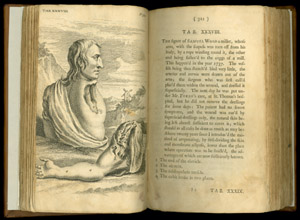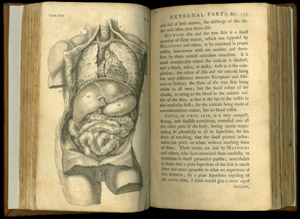William Cheselden (1688-1752)
The Anatomy of the Human Body. London: Printed by W. Bowyer, 1741. Fulltext available through Eighteenth Century Collections Online (UVa access only)

- William Cheselden, The Anatomy of the Human Body. Note the illustration of a camera obscura which was used to ensure the accuracy of Cheselden’s plates.

- William Cheselden, The Anatomy of the Human Body. Cheselden included case studies in his volume. This image explicitly portrays the injury of Samuel Wood whose arm and scapula were torn off when a rope fastened to cogs at a mill became entangled around his arm. The text indicates that the miller survived his accidental amputation.

- William Cheselden, The Anatomy of the Human Body. This table shows the internal organs and structures of the torso.
William Cheselden was a prominent British surgeon in the early eighteenth century. Recognizing a need to establish formal anatomy coursework, Cheselden offered private classes. As a surgeon, he developed a lateral perineal incision to remove stones from the bladder and became noted for this procedure. Critical in the days before anesthesia, his surgery took Cheselden only minutes to perform instead of hours, resulting in an operative mortality of less than ten percent. His first major work, The Anatomy of the Humane Body, (the e in humane was eventually dropped), was published in 1713 and became a standard medical textbook for nearly 100 years. Our sixth edition of The Anatomy of the Human Body has forty copper plates, thirteen more than the first edition. His greater achievement was Osteographia, or The Anatomy of the Bones, a volume depicting the human skeleton on a grand and beautiful scale.
next author: Bernhard Siegfried Albinus (1697-1770).